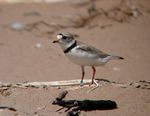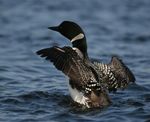Iron Mining In the Penokee Range- What's at Risk - Penokee Range
←
→
Page content transcription
If your browser does not render page correctly, please read the page content below
Introduction
The Penokee – Gogebic Range extends 25 miles in far northern Wisconsin, through Iron
and Ashland counties. The range consists of two steep, parallel ridges that dominate the
local landscape rising 1200 feet from nearby Lake Superior. The topography of the area
and the variety of soil conditions result in a wide range of habitat that supports a diverse
group of species and natural communities.
For decades, this property has been managed for hardwood timber production, including
maple and yellow birch. Pine, hemlock, ash and aspen are also on the property. Currently,
the majority of the land is enrolled in Wisconsin’s Managed Forest Law. Managed Forest
Law requires a management plan to sustain production of timber products and large areas
for public recreational uses, including hunting, hiking, and snowmobiling.
The forests provide habitat and hunting opportunities for upland birds and big game
including, ruffed grouse, white-tail deer and black bear. The forests are close to the state’s
reintroduced elk herd. Many of the streams on the property are Class I trout streams with
naturally reproducing populations of brook, brown and rainbow trout.
The majority of the Penokee Range is owned by RGGS Land and Minerals out of Houston
Texas and La Point Mining Co in Minnesota. Together, these companies control a narrow
22-mile, 22,000 acre band in the Penokee Range from southwest of Hurley, WI to about six
miles west of Mellen, WI. The Cline Group, out of Florida, has secured an option to obtain
the mineral rights held for this property and has created a subsidiary called Gogebic
Taconite (G-TAC) to move forward with the mining of iron.
Why is this land important
The Penokee mining land encompasses:
Nearly 35 square miles of northern
hardwood forest,
Fifty-six miles of perennial river and
stream frontage on more than 20
waterways,
Frontage on English and Beaver lakes.
It is in close proximity to
Copper Falls State Park,
The Nature Conservancy/DNR
cooperative project at Caroline Lake
State Natural Area,
Devil’s Creek State Fishery Area,
Segments of the North Country National
Trail.
This land helps maintain the forest cover in a
landscape that links the Chequamegon-Nicolet
National Forest in northern Wisconsin to the
Ottawa National Forest in the Upper Peninsula
of Michigan. This land provides habitat for wide
ranging mammals, such as timber wolves and
Pine martins, and for breeding populations of View from top of
migrant songbirds, such as the black-throated
blue warbler. Mount Whittlesey
© Dale A Thomas/NP Studios
2The Penokee Range is identified as an important area of high conservation significance due
to its unique geology; many rare plants, animals and forest communities; and high quality
recreational opportunities (WI Land Legacy Rpt, 2006). This landscape was included in the
DNR’s Forest Legacy Assessment of Need (2001); The Wisconsin Wildlife Action Plan
identified the Penokee Range as an Important Bird Area and a Conservation Opportunity
Area of Continental Significance to maintain a large continuous climate change resistant
forest (2008).
The Penokees have also been identified by The Nature Conservancy and its partners in the
Great Lakes Ecoregional Plan (2000) as a large block of forest important for declining forest
birds such as the golden-winged warbler, blackburnian warbler and goshawk. The forests
also provide an important function in maintaining the quality and quantity of water that
eventually empties into the Kakagon/Bad River Sloughs – a United State Department of
Interior designated National Natural Landmark.
Mount
Whittlesey
© Matt Dallman/TNC
© Scott W. Mulcahy © Scott W. Mulcahy
© Robert A. Kleppin © Lawrence Michael © Robert A. Kleppin
3Bad River
© Matt Dallman/TNC
Risks to Unique Water Resources
The Penokee mining land has the potential to impact a large portion of the headwaters of
the Bad River watershed. Fifty-six miles of perennial, and 15 miles of intermittent waterways
flow through the mining land. Due to their high elevation and close proximity to Lake
Superior, the Penokees average over 200 inches of snow a year. The quantity,
temperature, and nutrients of this water have significant impacts on water resources
downstream including the Bad River, the Kakagon/Bad River sloughs and finally Lake
Superior.
The Bad River flows through a wide variety of habitats in a relatively short span. Starting in
the forested heights of the Penokee range it quickly drops through deep forests in Copper
Falls State Park and over the escarpment into spectacular canyons and waterfalls. Below
Copper Falls, the Bad River flows through lowland forests and out to the sloughs where the
river meets Lake Superior. Segments of the Bad River, Kakagon River, Bear Trap Creek,
and Wood Creek are all designated as Outstanding Natural Resource Waters by the State
of Wisconsin. These systems are all dependent on surface and ground water that originates
in the Penokee Range. The Bad River also provides important spawning habitat for the lake
sturgeon and many game fish.
At the mouth of the Bad River are some of the largest and highest quality coastal wetlands
in the Great Lakes. The 16,000-acre Kakagon/Bad River Sloughs, which have been called
Wisconsin’s Everglades, are an ecosystem of national significance and were designated as
a National Natural Landmark by the U.S. Dept. of the Interior in 1983. The Kakagon-Bad
River Sloughs are home to many threatened and endangered species such as the Piping
Plover, Trumpeter Swan, Yellow Rail, Bald Eagle, wood turtle, and ram’s-head lady-slipper
orchid.
4The Penokee range is also a key piece of the land for
drinking water. This area makes up the headwaters of
the drinking water source both surface and
groundwater, for the Municipalities of Ashland, Mellen,
Highbridge, Marengo, Odanah, and Upson.
Finally the rise in elevation of the Penokees creates the
hydrologic pressure that supports the abundance of
artesian wells found along the Chequamegon Bay
shoreline. Within Lake Superior itself, the ground
water upwellings generated by this hydrologic pressure
are critical spawning areas for many great lakes fishes.
© Ryan Brady
Long Island,
Lake Superior
© Gerald H. Emmerich, Jr.
Piping Plover
Chequamegon Bay
© Ted Cline
5The following rivers/streams flow through the Penokee mining property (E and O indicate
that portions of these waterways are designated as Exceptional or Outstanding
Resource Waters):
Apple Creek Edies Creek Montreal Creek
Bad River (E and O) Erickson Creek Opergard Creek
Ballou Creek (E) Gehrman Creek Potato River (O)
Barr Creek (E) Gravelly Brook Rocky Run
Camp Six Creek Happy Creek Rouse Creek
City Creek Hardscrabble Creek Tafelski Creek
Devils Creek (E) Javorsky Creek (E) Tyler Forks (E and O)
Dunn Creek Krause Creek (E) Several unnamed
6Kakagon Sloughs
Tyler Forks
© Dale A. Thomas/NP Studios
Tyler Forks Falls
© Dale A. Thomas/NP Studios
© Dale A Thomas/NP Studios
Tyler Fork Falls
© Dale A. Thomas/NP Studios
7Conclusion
This document gives a short summary of the natural resources that have the potential to be
impacted by mining activities in the Penokee Range. It is critical that these unique resources be
identified, the threats to them recognized, and all efforts made to protect them. The Nature
Conservancy believes there are many questions that need be answered to make sound policy
decisions on this issue.
What is the exact location and extent of actual strip mine
Expansion plan – what is the potential scale of this mine 5, 10, 50 years
How much water (actual) will this mine use, where will it come from and how will it be returned
to the system
What will be leached from the exposed rock, how will this be contained from reaching surface
and ground water and how will it be treated
What impact will this mine have on surface and ground water
How does the groundwater move away from this site and what impact will that have on local
communities
How will the mine impact surface water, quality, quantity, timing and temperature
How will this project impact endangered species
It is our hope that due diligence is done so that thoughtful and informed decision are made on how to
proceed with any mining operation in this area. It is an area of the state that The Nature Conservancy
and its partners have been working in for a long time and we hope our experience can help inform good
policy decisions on this issue.
© Howard Moon
Caroline Lake,
Headwaters to Bad River
Contact:
© Gerald H. Emmerich, Jr.
Casey Eggleston
The Nature Conservancy
633 W. Main Street
Madison, WI 53703
ceggleston@tnc.org
608-316-6412
©Gerald H. Emmerich, Jr. 8You can also read



























































